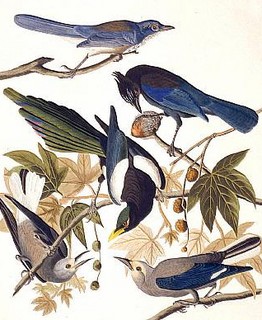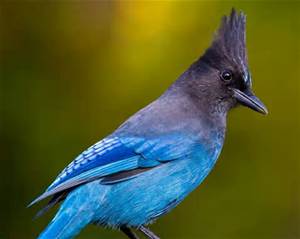Stellar’s jay is a common bird in western North American, its range extending from the Rockies west to the coast, up to SE Alaska and south through Mexico. This bird shows quite the variation in plumage, particularly where its range bumps up against the eastern blue jay (Cyanocitta cristata) but more on that later.
The head of the Stellar’s jay has prominent crest and is blackish-brown with light blue streaks on the forehead. The shoulders and lower breast are a silvery blue while the wings and tail are a dark blue with barring.
Steller’s jays inhabit coniferous forests but they are quite versatile and are found up to tree line in the mountains and in residential areas – you can easily come across them in Seattle. Steller’s jay typically builds a nest in conifer trees but sometimes take advantage of tree hollows to nest there. Two to six eggs are laid during the spring and are incubated by the female for 16 days.
This bird is named after Georg Wilhelm Steller, a German botanist, zoologist, physician, and explorer. In 1741 he first described the bird while on Vitus Bering’s second Kamchatka expedition, which recorded the strait between Russia and Alaska. Steller was granted only 10 hrs to explore Alaska’s Kayak Island on July 20, 1741, when he observed this jay. He also managed to discover a number of other species that bear his name – Steller’s sea cow and spectacled cormorant (both now extinct) and Steller’s sea lion, eider and sea eagle (all endangered). The Steller’s jay is the one common species he first described. Steller’s return trip didn’t go so well – the captain didn’t understand his use of berries to ward of scurvy, all but 12 of the crew were incapacitated, they shipwrecked, were constantly raided by Arctic foxes, and finally cobbled together a makeshift boat to return to Kamchatka in the spring of 1742. Cyanocitta – cyanos, Greek for blue and citta – jay. Stelleri honors Georg Steller.
Steller’s jay diet is mostly plant matter – except where its range is sympatric (overlaps) with the eastern blue jay. They typically eat a wide range of seed, nuts, berries, and other fruit. They will prey upon invertebrates, small rodents, eggs and nestlings, reptiles, and small snakes. In turn they are prey-upon by mid-sized hawks such as Cooper’s hawks. In north Seattle I once watched a Cooper’s hawk swoop and pick off an unaware Steller’s jay from his perch. The hawk went over to a tree to enjoy his meal and rip apart the jay. He tried to swallow a large part that didn’t quite work out so he had the jay’s foot sticking out of his mouth. After several unsuccessful swallows he changed tactics, lowered his head, pinned the jay’s foot against the branch with his foot, and yanked up his head dislodging the oversized drumstick from his throat.

Steller’s jay is one noisy critter with a signature call of Shack –sheck-sheck-sheck-sheck. Some calls are sex-specific; females produce a rattling sound and males make a high-pitched gleep-gleep sound. http://www.bing.com/videos/search?q=steller%27s+jay+sound&view=detail&mid=E875B2EE1FFDAFEFD4ADE875B2EE1FFDAFEFD4AD&FORM=VIRE
Steller’s jays also are known mimics – they will imitate the call of other birds such as red-tailed hawk, red-shouldered-hawk, osprey, and sharp-shinned hawk. It’s thought they use this tactic to induce other birds to seek cover while they causally feed on. A few times I’ve thought I heard a sharp-shinned hawk around my house only to find a Steller’s jay up in the tree.
